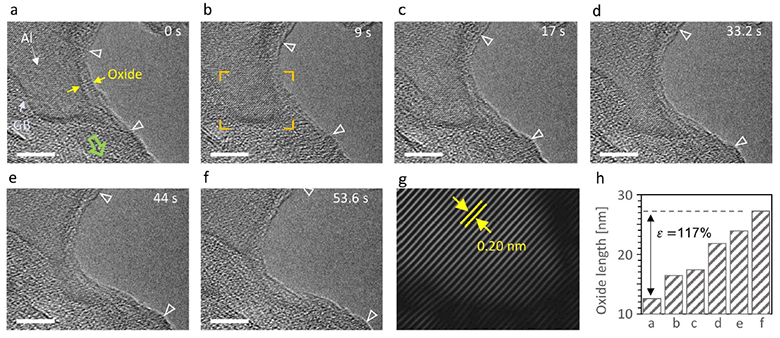 Liquid-like superplasticity of the alumina layer at room temperature ( video ). Sequential photographs under a transmission electron microscope (af) show the process of superstretching and self-healing of oxide under tension in a medium with an oxygen partial pressure of 2 × 10–6 Torr. The oxide is stretched between two white triangular marks. The green arrow in the first photo shows the direction of stretching. In image (g), the filtered and enlarged area is indicated by the orange rectangle in photo (b). The last image (h) shows the length of the oxides that are between the two triangular markers from photo (a).
Liquid-like superplasticity of the alumina layer at room temperature ( video ). Sequential photographs under a transmission electron microscope (af) show the process of superstretching and self-healing of oxide under tension in a medium with an oxygen partial pressure of 2 × 10–6 Torr. The oxide is stretched between two white triangular marks. The green arrow in the first photo shows the direction of stretching. In image (g), the filtered and enlarged area is indicated by the orange rectangle in photo (b). The last image (h) shows the length of the oxides that are between the two triangular markers from photo (a).Most metals, with the exception of gold, are oxidized in air in the presence of water. Rust forms on the surface of iron, fading on the surface of silver, green patina on the surface of copper or brass, etc. Over time, these natural chemical processes can weaken the metal, leading to cracks or structural damage.
But several specific oxides are known, including chromium oxide, silica and alumina. These substances in reality do not destroy, but
protect their metals / semimetals. A thin layer of oxides is formed on the surface of the material (chromium, silicon and aluminum), and no further oxidation occurs.
Scientists have long suspected that a thin oxide film has unique properties. They were not mistaken.
This is really a unique and very interesting property of these oxides, and it has long been of interest to scientists. After all, if we understand how and by what principles the formation of such films takes place, then they can be more effectively used as a protective coating, according to a
press release from the Massachusetts Institute of Technology. The film of Al
2 O
3 can provide absolute tightness and not miss a single molecule.
But in this case, the scientists did not set the task of developing some useful material, but simply wanted to see with their own eyes what unique properties these oxides manifest. For the first time in the world, videotaped behavior of the Al
2 O
3 film on the aluminum surface was made.
For shooting, they modified the standard transmission electron microscope (TEM) to remove the surface in the presence of arbitrary gases and liquids, and focused it on the tips of the thinnest aluminum needles welded by cold welding, that is, pressure with plastic deformation of the surfaces to be joined. After welding, the needles were placed in an aggressive oxygen environment - and began to stretch to the sides. Thus, the material was simultaneously subjected to stretching and oxidation — this is called “stress corrosion”, and under such conditions it is especially interesting to look at crack formation.
 Illustration of the strain of aluminum oxide in tension in aggressive environments
Illustration of the strain of aluminum oxide in tension in aggressive environmentsAs it turned out, aluminum oxide is in fact deformed like a liquid, showing superplasticity. The protective coating of oxide lengthens with the elongation of the metal itself. At an average rate of stretching, the oxide does not form any cracks. The video below is recorded at a higher corrosive corrosion rate when the oxide exhibits “self-healing” properties, filling in damage.
 A thin oxide layer separates the oxygen (to the right) from the aluminum grains (to the left). As the material stretches, the oxide layer becomes longer.
A thin oxide layer separates the oxygen (to the right) from the aluminum grains (to the left). As the material stretches, the oxide layer becomes longer."In contrast to the traditional process of thin film growth or nanoglass consolidation, we observe a seamless fusion of new oxide islands without the formation of any glass-glass joints or surface grooves, which indicates a significantly accelerated kinetics of glass on the surface compared to the rest", - scientists note.
Alumina exhibits these unique properties even at room temperature if its film is thin enough (2-3 nanometers). The film can stretch more than twice. Technically, this material is glass, but it exhibits the properties of a liquid.
The scientific article was
published on February 28, 2018 in the journal
Nano Letters (doi: 10.1021 / acs.nanolett.8b00068,
pdf ).